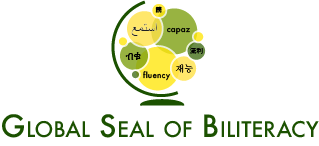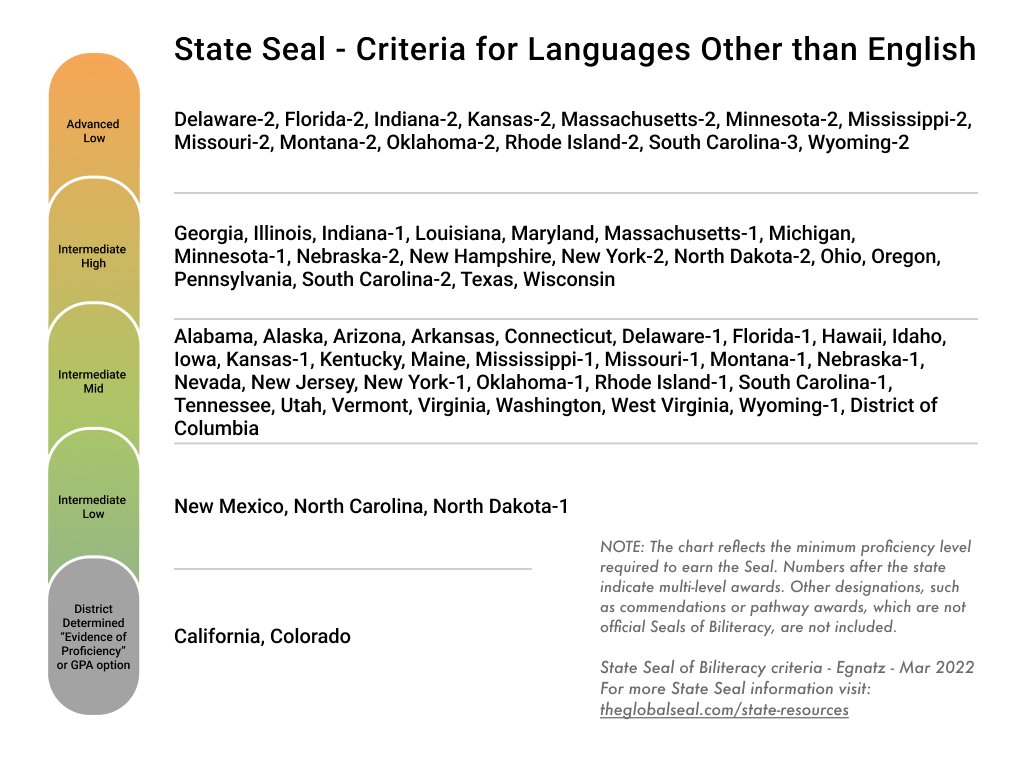What is the Seal of Biliteracy?
The Seal of Biliteracy recognizes that an individual has attained a certain level of proficiency in two or more languages. A Seal of Biliteracy is typically awarded in the form of a certificate and can be used as a credential to convey an individual’s proficiency in two or more languages.
What does the Seal of Biliteracy do for you?
Being able to speak more than one language is a valuable asset that can open up many doors in an individual’s life. A Seal of Biliteracy can be a powerful tool to earn college credit, apply for a scholarship or study abroad program, access greater career opportunities, and qualify for pay differentials. According to the 2019 report, Making Languages Our Business: Addressing Foreign Language Demand Among U.S. Employers, by Ipsos Public Affairs that surveyed 1,200 U.S. employers, language skills are critically needed in a wide variety of career sectors and may result in higher salaries. Some states offer State Seal of Biliteracy recipients automatic college credit at their state university institutions. Regardless having a Seal of Biliteracy can help you stand out on college applications, such as the Common App.
Seal of Biliteracy requirements
U.S. State Seals of Biliteracy are generally awarded to high school seniors but in many states are only available to students who attend public schools. Criteria for state Seals are determined by a state, district or school as determined by each state. Below is a map of the United States, click on your state below to learn more about their Seal of Biliteracy program. The Global Seal of Biliteracy is a language credential issued in collaboration with a school or organization and the Global Seal of Biliteracy, an independent international certifying body. It can be awarded to anyone, student or adult, from any state or country, that has met the criteria for one of its two award levels on one of its qualifying tests. The Global Seal of Biliteracy is serial-numbered and can be listed as a certificate, not just an award, on a CV or LinkedIn digital profile.
How can you earn a seal of biliteracy?
Each Seal of Biliteracy has their own criteria that needs to be met in order to be awarded a Seal of Biliteracy. This includes a required level of language proficiency aligned with either the ACTFL or CEFR Proficiency Scales. Most Seals of Biliteracy require an approved language assessment to be taken or a certain grade point average (GPA) to be reached in language study. To learn more about an individual state’s Seals of Biliteracy click on your state below on the map. The Global Seal of Biliteracy website provides a list of qualified tests and scores that are accepted in order to be awarded one of its three award levels, Functional Fluency, Working Fluency or Professional Fluency.
Where Can You Earn a Seal of Biliteracy?
Currently, 50 states and the District of Columbia offer a state Seal of Biliteracy program. Click on your state on the map below to find information on their Seal of Biliteracy Program. The Global Seal of Biliteracy is currently available to anyone, anywhere who meets the testing requirements, regardless of language, age, grade, school, etc.
Frequently Asked Questions
-
The specific requirements can vary by state, but generally, you need to demonstrate proficiency in English and another language. This is often done through standardized tests, coursework, and sometimes an oral interview or presentation. Use the map above to look at your state’s specific requirements.
-
The Global Seal of Biliteracy is universal, it crosses state lines and can be issued in any country whereas the U.S. State Seals are generally available to students graduating from a public school in a state and individual district or school that has adopted the program (with some exceptions). The Global Seal of Biliteracy credentials all qualifying language learners, including those who have already graduated from high school, but would like to certify their language skills for academic or work purposes. The Global Seal is often used in partnership with state Seals to provide earlier benchmark awards or an alternative award to language learners above or below state Seal criteria. Schools often adopt both programs.
-
Yes, colleges often view the Seal of Biliteracy favorably as it demonstrates a student's proficiency in two or more languages, which can be an asset in today's globalized world. Some may even offer a scholarship, college credit, or placement for it.
-
This can vary greatly by college. Some colleges may give credit for language courses, while others may simply view it as a positive factor in admissions. It is best to reach out to the college or university’s language department to see what may be available to you.
The Global Seal of Biliteracy has developed higher education pathways that can be viewed by clicking here. -
Yes, to learn more about how and where to add your Seal of Biliteracy or Global Seal of Biliteracy to your Common App see our blog post.
-
It can vary by state but typically It's considered an honor. It's a recognition of the student's accomplishment in achieving proficiency in two or more languages.
-
There is no cost to the student to receive the Seal of Biliteracy. It's a recognition given by the state or school district. However in some cases, students may have to pay for testing.
-
No, the Seal of Biliteracy is not an AP test. However, high scores on AP language exams can sometimes be used to qualify for the Seal of Biliteracy.
-
This can vary by state, but often a score of 3 or higher on an AP language exam is needed to qualify.
-
The most common way to prove that you are bilingual is through proficiency testing. The most common tests used to earn a Seal of Biliteracy are the AP (Advanced Placement), STAMP 4S, or AAPPL
Click on a State below to learn more about thier Seal of Biliteracy program
Year of Adoption by States
| 2011 | California |
| 2013 | Illinois, Texas, New York |
| 2014 | New Mexico, Washington, Louisiana, Minnesota, District of Columbia |
| 2015 | North Carolina, Indiana, Virginia, Nevada, Hawaii, Wisconsin, Utah |
| 2016 | New Jersey, Oregon, Maryland, Florida, Georgia, Kansas, Arizona, Rhode Island |
| 2017 | Colorado, Ohio, Missouri, Delaware, Connecticut, Massachusetts |
| 2018 | Arkansas, Iowa, Michigan, Tennessee, South Carolina, Maine |
| 2019 | North Dakota, Mississippi |
| 2020 | Nebraska, New Hampshire, Idaho, Oklahoma, Vermont |
| 2021 | Kentucky, Montana, West Virginia |
| 2022 | Alabama, Alaska, Pennsylvania, Wyoming |
The Global Seal of Biliteracy complements and supports the individual state Seals of Biliteracy. The organization is committed to expanding the opportunity to demonstrate and document one's bilingualism. The Global Seal of Biliteracy certification meets or exceeds the requirements of all existing U.S. state Seal programs, and offers a uniform standard to recognize language skills at levels that are meaningful for academic and workplace environments. It allows recipients to showcase their language skills to any school or employer across state lines and international borders. The Global Seal of Biliteracy is proof of your language proficiency at one of three fluency levels.








